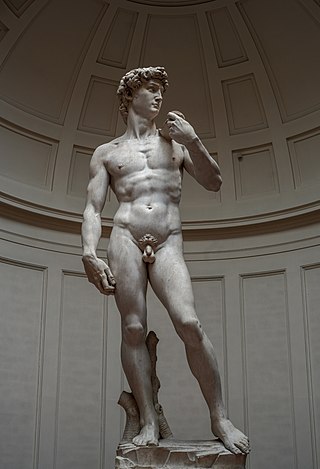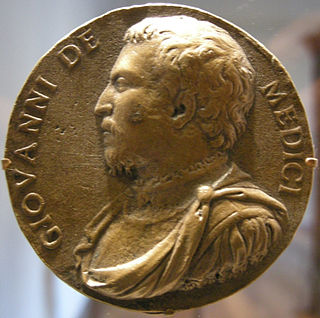
Bartolomeo Ammannati was an Italian architect and sculptor, born at Settignano, near Florence. He studied under Baccio Bandinelli and Jacopo Sansovino and closely imitated the style of Michelangelo.

Michelangelo di Lodovico Buonarroti Simoni, known as Michelangelo, was an Italian sculptor, painter, architect, and poet of the High Renaissance. Born in the Republic of Florence, his work was inspired by models from classical antiquity and had a lasting influence on Western art. Michelangelo's creative abilities and mastery in a range of artistic arenas define him as an archetypal Renaissance man, along with his rival and elder contemporary, Leonardo da Vinci. Given the sheer volume of surviving correspondence, sketches, and reminiscences, Michelangelo is one of the best-documented artists of the 16th century. He was lauded by contemporary biographers as the most accomplished artist of his era.

In Greek mythology, a satyr, also known as a silenus or silenos, and selini (plural), is a male nature spirit with ears and a tail resembling those of a horse, as well as a permanent, exaggerated erection. Early artistic representations sometimes include horse-like legs, but, by the sixth century BC, they were more often represented with human legs. Comically hideous, they have mane-like hair, bestial faces, and snub noses and they always are shown naked. Satyrs were characterized by their ribaldry and were known as lovers of wine, music, dancing, and women. They were companions of the god Dionysus and were believed to inhabit remote locales, such as woodlands, mountains, and pastures. They often attempted to seduce or rape nymphs and mortal women alike, usually with little success. They are sometimes shown masturbating or engaging in bestiality.

David is a masterpiece of Italian Renaissance sculpture, created from 1501 to 1504 by Michelangelo. With a height of 5.17 metres, the David was the first colossal marble statue made in the early modern period following classical antiquity, a precedent for the 16th century and beyond. David was originally commissioned as one of a series of statues of prophets to be positioned along the roofline of the east end of Florence Cathedral, but was instead placed in the public square in front of the Palazzo della Signoria, the seat of civic government in Florence, where it was unveiled on 8 September 1504. In 1873, the statue was moved to the Galleria dell'Accademia, Florence, and in 1910 replaced at the original location by a replica.

Praxiteles of Athens, the son of Cephisodotus the Elder, was the most renowned of the Attica sculptors of the 4th century BC. He was the first to sculpt the nude female form in a life-size statue. While no indubitably attributable sculpture by Praxiteles is extant, numerous copies of his works have survived; several authors, including Pliny the Elder, wrote of his works; and coins engraved with silhouettes of his various famous statuary types from the period still exist.

Baccio Bandinelli, was an Italian Renaissance sculptor, draughtsman, and painter.

Jacopo d'Antonio Sansovino was an Italian Renaissance sculptor and architect, best known for his works around the Piazza San Marco in Venice. These are crucial works in the history of Venetian Renaissance architecture. Andrea Palladio, in the Preface to his Quattro Libri was of the opinion that Sansovino's Biblioteca Marciana was the best building erected since Antiquity. Giorgio Vasari uniquely printed his Vita of Sansovino separately.

Giovanni Angelo Montorsoli, also known as Giovann'Agnolo Montorsoli, was a Florentine sculptor and Servite friar. He is today as often remembered for his restorations of famous classical works as his original creations.

The Florence Baptistery, also known as the Baptistery of Saint John, is a religious building in Florence, Italy, and has the status of a minor basilica. The octagonal baptistery stands in both the Piazza del Duomo and the Piazza San Giovanni, across from Florence Cathedral and the Campanile di Giotto.

The Apollo Belvedere is a celebrated marble sculpture from classical antiquity.

A wax sculpture is a depiction made using a waxy substance. Often these are effigies, usually of a notable individual, but there are also death masks and scenes with many figures, mostly in relief.

The Loves of the Gods is a monumental fresco cycle, completed by the Bolognese artist Annibale Carracci and his studio, in the Farnese Gallery which is located in the west wing of the Palazzo Farnese, now the French Embassy, in Rome. The frescoes were greatly admired at the time, and were later considered to reflect a significant change in painting style away from sixteenth century Mannerism in anticipation of the development of Baroque and Classicism in Rome during the seventeenth century.

Bacchus (1496–1497) is a marble sculpture by the Italian High Renaissance sculptor, painter, architect and poet Michelangelo. The statue is somewhat over life-size and represents Bacchus, the Roman god of wine, in a reeling pose suggestive of drunkenness. Commissioned by Raffaele Riario, a high-ranking Cardinal and collector of antique sculpture, it was rejected by him and was bought instead by Jacopo Galli, Riario's banker and a friend to Michelangelo. Together with the Pietà, the Bacchus is one of only two surviving sculptures from the artist's first period in Rome.

The marble Gaddi Torso displayed in the Classical Sculpture Room of the Uffizi, Florence, is a Hellenistic sculpture of the 2nd century BCE.

Danese Cattaneo was an Italian sculptor and medallist, active mainly in the Veneto Region.

Apollo, also known as Apollo-David, David-Apollo, or Apollino, is a 1.46 m unfinished marble sculpture by Michelangelo that dates from approximately 1530. It now stands in the Bargello museum in Florence.

The Rothschild Bronzes, also known as the Michelangelo Bronzes, are a pair of 16th century statuettes, each depicting a nude male figure riding a mythological animal, usually identified as a panther. Mirroring each other in pose, the nude men are distinguished by age, one young, the other bearded. The younger man is 76.6 cm, the other almost 90 cm high. The sculptures are unsigned and the figures and panthers have been separately cast. The bronzes were displayed to the public at the Fitzwilliam Museum, University of Cambridge, from February to August 2015 with an attribution to Michelangelo. If the attribution is correct, Michelangelo would have made the bronzes around 1506 to 1508, before the painting of the Sistine Chapel ceiling but after the marble statue of David. The sculptures would be the only autograph bronze works by Michelangelo to have survived.

The Loggetta is a small, richly decorated building at the base of the bell tower in Saint Mark's Square, Venice, Italy. Built by Jacopo Sansovino between 1538 and 1546, it served at various times as a gathering place for nobles and for meetings of the procurators of Saint Mark, the officials of the Venetian Republic who were responsible principally for the administration of the treasury of the Church of Saint Mark and for the public buildings around Saint Mark's Square.

Italian Renaissance sculpture was an important part of the art of the Italian Renaissance, in the early stages arguably representing the leading edge. The example of Ancient Roman sculpture hung very heavily over it, both in terms of style and the uses to which sculpture was put. In complete contrast to painting, there were many surviving Roman sculptures around Italy, above all in Rome, and new ones were being excavated all the time, and keenly collected. Apart from a handful of major figures, especially Michelangelo and Donatello, it is today less well-known than Italian Renaissance painting, but this was not the case at the time.

Renaissance sculpture is understood as a process of recovery of the sculpture of classical antiquity. Sculptors found in the artistic remains and in the discoveries of sites of that bygone era the perfect inspiration for their works. They were also inspired by nature. In this context we must take into account the exception of the Flemish artists in northern Europe, who, in addition to overcoming the figurative style of the Gothic, promoted a Renaissance foreign to the Italian one, especially in the field of painting. The rebirth of antiquity with the abandonment of the medieval, which for Giorgio Vasari "had been a world of Goths", and the recognition of the classics with all their variants and nuances was a phenomenon that developed almost exclusively in Italian Renaissance sculpture. Renaissance art succeeded in interpreting Nature and translating it with freedom and knowledge into a multitude of masterpieces.




















